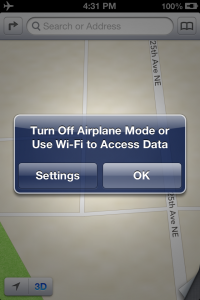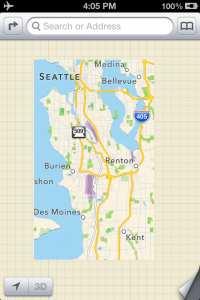A few days ago, the makers of Snappli, an Android and iPhone app that is supposed to reduce and secure your mobile phone data usage though they’d get some free press by jumping on the iOS 6 Map.app-bashing bandwagon.
They looked at their data about network usage and drew the following conclusions:
- 64% of Snappli users have migrated to iOS 6 within the last few weeks (UK and US)
- Before the upgrade to iOS 6, 25% of Snappli users were viewing Google Maps at least once a day
- Once they moved to iOS 6, that immediately went to 35% of users using Apple Maps
- However, over the next 5 days that drops down to 4%
Their summary:
Before iOS 6 1 in 4 people were using Google maps at least once a day. After iOS 6: 1 in 25 using Apple maps and falling.
Damning, right? Well, not so fast. People have pointed out that iOS maps use much less data. Snappli answers that they weren’t looking at overall Maps data usage, they were looking at actual use of the app. Of course, that’s probably not quite true.
There is very little an iOS App can see about usage of other apps. Snappli can see more than others though, because it intercepts network traffic on the phone. It shouldn’t be able to see which app is accessing the network, but based on the remote hosts being accessed is accessing, they should be able to make guesses about what application is being used. There are a few factors that call into question the accuracy of their guesses though.
First, since the Map.app is a relatively new application, and they were likely in a hurry to take advantage of the bad press surrounding some of its shortcomings they might not have a complete picture of all the remote hosts it accesses over days of use, so they might be missing traffic that indicates use of the Map.app.
Second, and more importantly, the new version of the Map.app doesn’t just use less data when talking to remote servers, it has to requires it less often, much less often. To demonstrate, I put my iPhone in airplane mode, which cuts it off from any Internet access. Next I launched the iOS 6 Map application. I got a warning that I needed to turn on the network to use Maps, but when I dismissed that warning, I could see a map of the area near my home, where I last used the app. When I zoomed out, I could still see a map, so I zoomed out even further until I could see the limits of the cached data.
iOS 6 had cached data for more than one hundred square miles around Seattle. The screenshot below shows that it has even cached building-level detail for parts of Seattle I haven’t even been within a mile or more of since upgrading to iOS 6.

Snappli’s data tells a very different story if you take this behavior into account. Most people cover the same territory in a typical day, or week. If they use the iOS 6 apps a few times, it is likely to cache a significant amount of the map data they need, it is only when they leave that beaten path, or do a text search for a location that the Map app will have to connect to a server on the Internet.
If we assume that after upgrading to iOS 6 and checking out the new maps the average iPhone users go back to using the app once every four days, then Snappli’s data suggests that they only do a text search, or need new map data once every six uses of the app. That doesn’t seem unreasonable, does it?
We don’t really have enough information to know for sure what is going on, but it does seem likely that Snappli’s data supports the idea that people are using iOS 6 maps just as much as they used iOS 5 maps as it does to support, while, on the other hand, it is likely that their interpretation severely overexaggerates a decline in usage, if such a decline does indeed exist.
Unfortunately, Kevin Tofel of GigaOm, while acknowledging some of the criticisms of Snappli’s data is uncritical in accepting the company’s defense of their methodology. Kevin, here is the thing, the data may “seem legit,” but the interpretation is bogus, because it doesn’t take into consideration, or even acknowledge, that there are alternative interpretations that might also explain the observed behavior.

